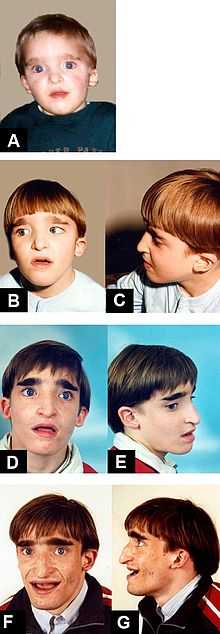Mowat–Wilson syndrome
| Mowat–Wilson syndrome | |
|---|---|
| Classification and external resources | |
 Mowat–Wilson syndrome, clinical features of Patient 2 at age: (A) 1 year and 6 months; (B–C) 3 years and 5 months; (D–E) 8 years and 1 month. | |
| OMIM | 235730 |
| DiseasesDB | 32975 |
Mowat–Wilson syndrome is a rare genetic disorder that was clinically delineated by Dr. D. R. Mowat and Dr. M. J. Wilson in 1998.[1]
Presentation

This autosomal dominant disorder is characterized by a number of health defects including Hirschsprung's disease, mental retardation, epilepsy,[2] delayed growth and motor development, congenital heart disease, genitourinary anomalies and absence of the corpus callosum. However, Hirschsprung's disease is not present in all infants with Mowat–Wilson syndrome and therefore it is not a required diagnostic criterion.[3] Distinctive physical features include microcephaly, narrow chin, cupped ears with uplifted lobes with central depression, deep and widely set eyes, open mouth, wide nasal bridge and a shortened philtrum.
Causes
The disorder is expressed in an autosomal dominant fashion and may result from a de novo (new) mutation or deletions of the ZEB2 (also known as ZFHX1B or SMADIP1) gene on chromosome 2q22.[4]
However, some of those affected by the disease do not have abnormalities of this gene that are currently detectable.[citation needed]
Prognosis
There is no cure for this syndrome. Treatment is supportive and symptomatic. All children with Mowat–Wilson syndrome required early intervention with speech therapy and physical therapy.[3]
References
- ↑ Mowat, DR; Croaker, GD; Cass, DT; Kerr, BA; Chaitow, J; Adès, LC; Chia, NL; Wilson, MJ (1998). "Hirschsprung disease, microcephaly, mental retardation, and characteristic facial features: Delineation of a new syndrome and identification of a locus at chromosome 2q22-q23". Journal of medical genetics 35 (8): 617–23. doi:10.1136/jmg.35.8.617. PMC 1051383. PMID 9719364.
- ↑ Cordelli, DM; Garavelli, L; Savasta, S; Guerra, A; Pellicciari, A; Giordano, L; Bonetti, S; Cecconi, I et al. (2013). "Epilepsy in Mowat-Wilson syndrome: Delineation of the electroclinical phenotype". American journal of medical genetics. Part A 161A (2): 273–84. doi:10.1002/ajmg.a.35717. PMID 23322667.
- ↑ 3.0 3.1 Todo A, Harrington JW. New-onset seizures in infant with square facies, hypospadias, and Hirschsprung disease. Consultant for Pediatricians. 2010;9:103-107.
- ↑ "ZEB2 - zinc finger E-box binding homeobox 2". HUGO Gene Nomenclature Committee. 11 January 2011. Retrieved 2 May 2011.
Further reading
- Cerruti Mainardi, P; Pastore, G; Zweier, C; Rauch, A (2004). "Mowat-Wilson syndrome and mutation in the zinc finger homeo box 1B gene: A well defined clinical entity". Journal of medical genetics 41 (2): e16. doi:10.1136/jmg.2003.009548. PMC 1735678. PMID 14757866.
- Mowat, DR; Wilson, MJ; Goossens, M (2003). "Mowat-Wilson syndrome". Journal of medical genetics 40 (5): 305–10. doi:10.1136/jmg.40.5.305. PMC 1735450. PMID 12746390.
External links
| Wikimedia Commons has media related to Mowat–Wilson syndrome. |
- Centre for Genetics Education in Sydney, Australia (PDF Information Sheet)
- Documentary about a young man with Mowat–Wilson syndrome
- extensive links page
- GeneReview of Mowat–Wilson syndrome